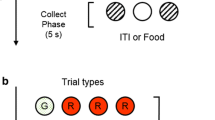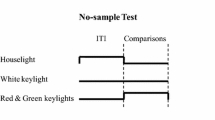Abstract
Four pigeons responded under chained variable-interval schedules in which the required response topographies were either similar (i.e., a homogeneous chain) or dissimilar (i.e., a heterogeneous chain). The pigeons were exposed to all possible combinations of initial-link key pecking or treadle pressing and terminal-link pecking or treadling. Three of four birds displayed higher initial-link response rates under the homogeneous chains. These results were explained in terms of an induction effect in which the strengthening effect of reinforcing a particular terminal-link response topography generalizes to similar responses earlier in the chain but not to topographically different responses.
Similar content being viewed by others
References
BROWN, P. L., & JENKINS, H. M. (1968). Auto-shaping of the pigeon’s key-peck. Journal of the Experimental Analysis of Behavior, 11, 1–8.
CATANIA, A. C., & REYNOLDS, G. S. (1968). A quantitative analysis of the responding maintained by interval schedules of reinforcement. Journal of the Experimental Analysis of Behavior, 11, 327–383.
D’ANDREA, T. (1969). Extinction of a heterogeneous chain after several reinforcement schedules. Journal of the Experimental Analysis of Behavior, 12, 127–135.
FLESHLER, M., & HOFFMAN, H. S. (1962). A progression for generating variable-interval schedules. Journal of the Experimental Analysis of Behavior, 5, 529–530.
KELLEHER, R., & GOLLUB, L. (1962). A review of positive conditioned reinforcement. Journal of the Experimental Analysis of Behavior, 5, 543–597.
KELLER, F. S., & SCHOENFELD, W. N. (1950). Principles of psychology. New York: Appleton-Century-Crofts.
LATTAL, K. A., & CRAWFORD-GODBEY, C. L. (1985). Homogeneous chains, heterogeneous chains, and delay of reinforcement. Journal of the Experimental Analysis of Behavior, 44, 337–342.
SCHROLL, P. (1985). Effects of time delays on autoshaping. Unpublished manuscript.
SKINNER, B. F. (1953). Science and human behavior. New York: Macmillan.
SKINNER, B. F. (1957). Verbal behavior. Englewood Cliffs, NJ: Prentice-Hall.
SCHWARTZ, B., & GAMZU, E. (1977). Pavlovian control of operant behavior. In W. K. Honig & J. E. R. Staddon (Eds.), Handbook of operant behavior (pp. 53–97). Englewood Cliffs, NJ: Prentice-Hall.
Author information
Authors and Affiliations
Additional information
These data were part of a master’s thesis submitted to the faculty of The Graduate College at Western Michigan University.
Rights and permissions
About this article
Cite this article
Starin, S.P. Responding Under Homogeneous Versus Heterogeneous Chained Schedules. Psychol Rec 37, 69–77 (1987). https://doi.org/10.1007/BF03395874
Published:
Issue Date:
DOI: https://doi.org/10.1007/BF03395874




